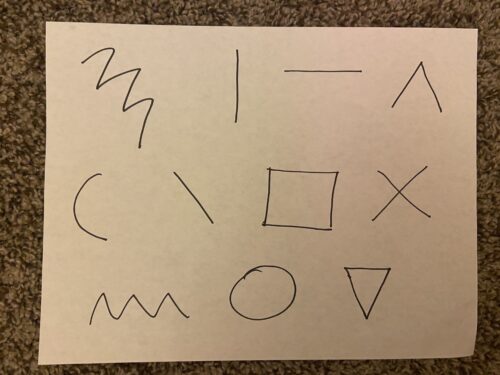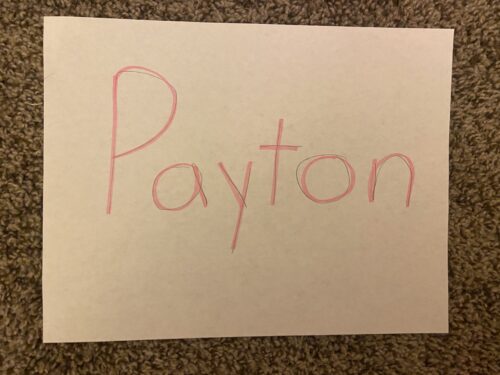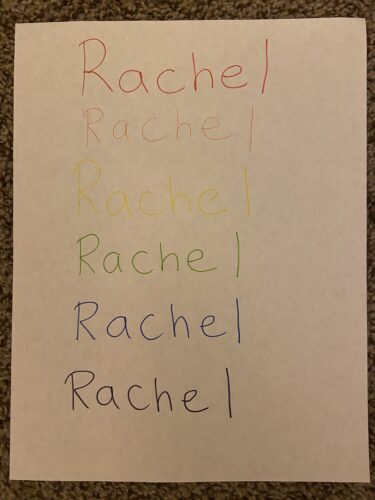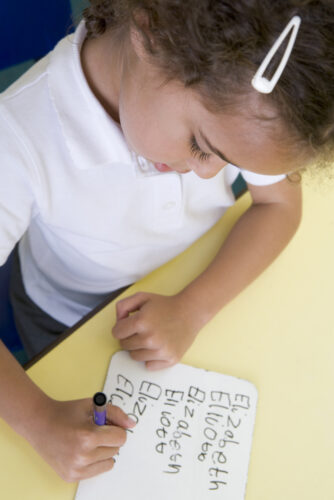One of the first tasks your child will work on during the first day of Kindergarten is writing their name. Being able to write their name before that first day can give your child a big confidence boost during the exciting but sometimes nerve-wracking transition to Kindergarten.
As a former Kindergarten teacher, I know that these tips can help get your child writing their name before that first day.
Teaching your child to write his or her name consists of three steps: preparation, practice, and repetition.
Preparation

Pre-Writing Skills
Before your child can learn to write their name, they need to have the fine motor skills needed in order to actually be able to do it. This means that they need to work on what we call “pre-writing skills”.
Children need to have the necessary hand strength in order to hold the writing utensil and create the letters correctly. There are many activities you can do to work on hand strength and the ability to create small lines and curves.
- Play with play-doh or other squishy objects to strengthen hand muscles.
- Practice writing lines, circles, zigzags, and other shapes with a variety of writing utensils.
- Practice pincer grasp by picking up small objects such as Cheerios or playing a game like the Coogam Toddler Fine Motor Skill Clamp Bee to Hive Matching Game.
Letter Awareness/Recognition
Although children do not need to recognize all the letters or sounds of the alphabet before being able to write their name (they will learn that in Kindergarten!), they should know at least know the ones in their name. It is also important that they realize the idea that words are made of individual letters that make different sounds.
Lastly, they also should be able to recognize their name when written out.
Here are some fun activities your child can do to practice recognizing and knowing the letters in their name.
- Search for the letters in their name in books, food labels, or signs.
- Read, read, read! Books can offer many letter learning and recognition opportunities. There are so many benefits of reading to children!
- Practice spelling their name out loud by singing a fun song like “Bingo” (use name instead of bingo in song).
- Practice identifying and putting the letters of the name in order with a name puzzle like the Fat Brain Wooden Personalized Name Puzzle.
- Allow them to see their name written often and point it out.
- Create a list of names (use familiar friends and family names) and challenge your child to find their own name.
- Hide names or other words written on cards around the house and play a game where your child needs to find their own name.
Practice

Once your child has the hand strength to hold a writing utensil, can create small lines and shapes, and is familiar with the letters in their name, it is time to practice, practice, practice!
Make It Fun
Most 4- to 5-year-olds do not want to sit and write their name over and over again with a pencil. Doing this will most likely discourage your child from wanting to write their name. Luckily, there are many different fun ways for kids to practice writing their names.
- Have your child use their finger to write their name in a variety of materials such as sand, rice, salt, shaving cream, or finger paint.
- Use a variety of writing utensils for practice such as chalk, markers, paintbrushes, or crayons. When they are first starting out, they may need a larger utensil such as a marker or toddler crayon. Then progress to smaller writing utensils as they improve.
Other Practice Tips
- Have an adult write the name with a highlighter and the child use a different writing utensil to trace over the letters. The adult can also make dashes to create an outline of the letters for the child to trace.
- Have a card or poster with your child’s name written on it handy so that they can refer to it when writing. They may need the reminder of the letters and their order for a while and that is normal.
- When first starting out, hold your child’s hand while they write the letters. This can help them learn the strokes and where to start and end the letter.
- When your child is first learning to write their name, it will not be a small name at the top of a page. It will likely be quite large. Make sure to offer a large space for them to practice.
- Use a whiteboard and dry erase markers! They are perfect because they are a great size and kids can practice over and over again without any waste.
Repetition

Once your child can write their name well, it is important that they continue to write it all the time. This is where repetition comes in. When they go to Kindergarten, they will most likely need to write their name on their work every day. Here are some fun ways to practice name writing repetition at home.
- Have your child write their name on every drawing, painting, or art project that they create.
- Make it a competition! Set a timer for 1 minute and see how many times they can write their name (neatly!) before the timer goes off. Do it again to see if they can get more.
- Rainbow writing! Have them write their name on one page in each color of the rainbow.
- If you have a chore chart or schedule at home, allow them to write their name next to the completed chore or activity, instead of using a checkmark or sticker.
FAQ About Teaching Kids to Write Their Names
When should kids be able to write their names?
Children should be able to write their names around ages 4-5, but it does not need to be perfect. By age 5, children should be able to print some letters and numbers on their own. They may still need a visual to look at to remember the letters and order. Letters may be written in reverse, or upper and lowercase letters confused. As they get older, the name writing will become more refined. This is why repetition is important!
Should kids write in uppercase or lowercase first?
Uppercase letters are easier to write, so many children will be able to write uppercase letters before lowercase letters. That being said, there are very few words that we write on a day-to-day basis that are all uppercase. Uppercase and lowercase letters should be taught at the same time. This helps children understand that they are the same letter, there are just different ways of writing them.
Although you can teach your child to write their name in uppercase, most of their practice should be just the first letter uppercase and the rest lowercase, as the name should typically be written. Children may just need some more practice with the lowercase letters versus the uppercase letters.
Do I need to teach my child to write their last name?
Eventually, your child will need to write their last name. You can teach them to write their last name while teaching them to write their first, or wait until they master writing their first name. Writing last names isn’t something that is very necessary for Kindergarten or 1st grade so I wouldn’t worry about it too much, just offer it as a challenge.
They will learn to write their last name eventually. You may want to teach them to write the first initial of their last name though, in case there is another child with the same name in their class!
Wrap Up
Writing our name is something we do as adults very often, and something that children do multiple times a day in school. It is a crucial skill to learn and with these tips, your child will be able to be a name writing expert before their first day of Kindergarten.
Preparation
- Strengthen fine motor abilities such as the pincer grasp.
- Draw a variety of lines and shapes.
- Learn the names of the letters in your name.
- Learn the order of the letters in your name.
- Be able to recognize what your name looks like compared to other names and words.
Practice
- Use a variety of writing utensils to practice (larger ones to start).
- Make it fun by having your child write their name in materials such as shaving cream or sand.
- Create an outline of the name for your child to trace.
- Help your child learn the movements by holding their hand.
Repetition
- Allow your child to continue to write their name to practice.
- Have your child write their name whenever they can. On art projects, chore charts, schedules, etc.
- Practice in fun ways such as rainbow writing or timed writing.
Practice makes perfect! As long as you give your child lots of opportunities to practice name writing in a variety of fun ways during the day, they will be writing it without a problem in no time!







